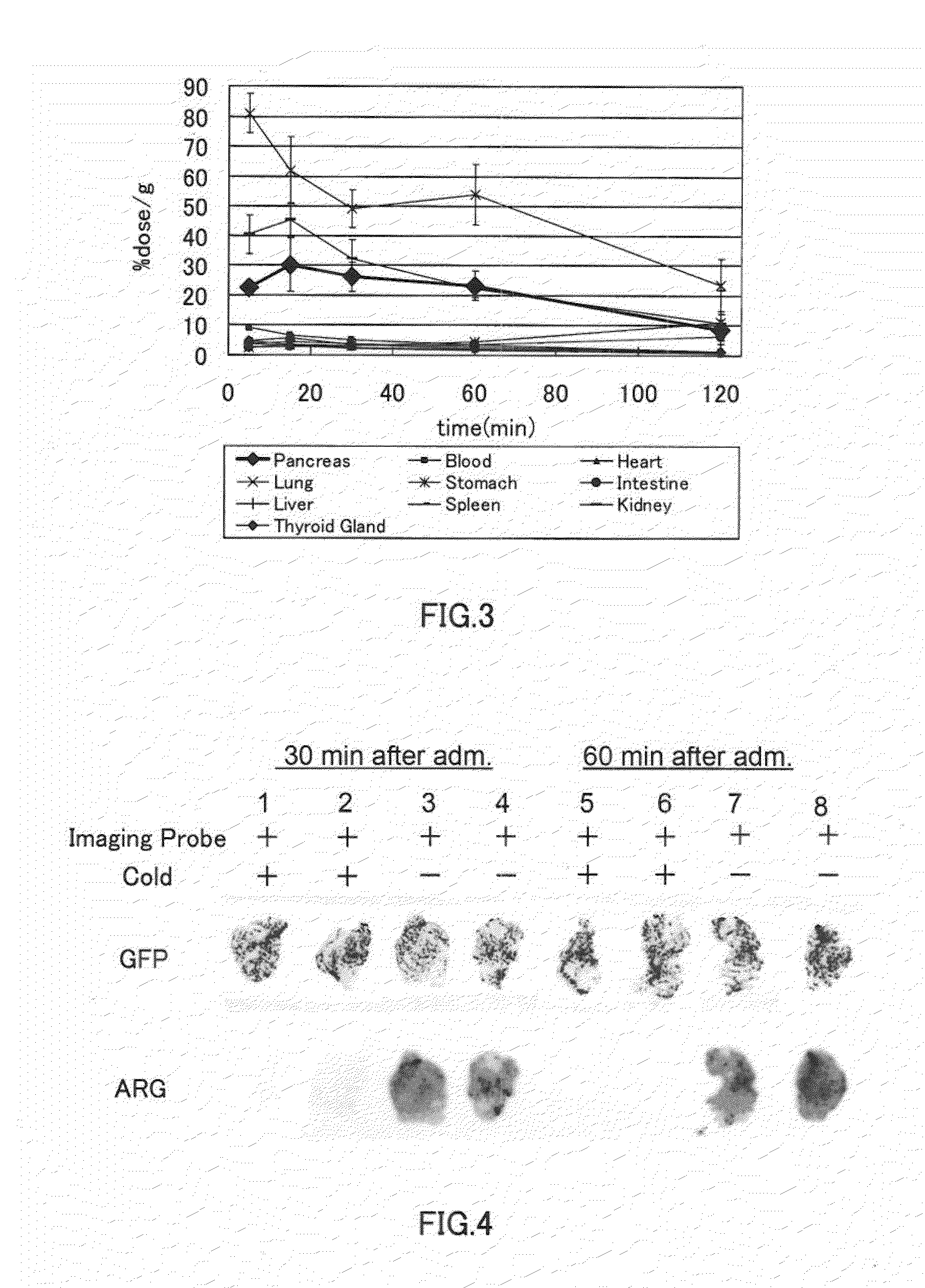Method for Producing Radioactively Labeled Polypeptide
a polypeptide and radioactive technology, applied in the field of radioactively labeled polypeptide production, can solve the problems of difficult to specifically label the target labeling site, difficult to achieve radiochemical purity and radiochemical yield of the obtained molecular probe, complicated labeling process, etc., and achieve high yield
- Summary
- Abstract
- Description
- Claims
- Application Information
AI Technical Summary
Benefits of technology
Problems solved by technology
Method used
Image
Examples
example 1
[0144]A biodistribution experiment and a two-dimensional imaging analysis of mice were performed using the polypeptide represented by the formula (15) (hereinafter referred also to as “the polypeptide of Example 1”).
[0145][Biodistribution]
[0146]The polypeptide of Example 1 (0.75 μCi) was administered to unanesthetized 6-week-old ddY mice (male, weight: 30 g) by intravenous injection (through the tail vein). After 5 minutes, 15 minutes, 30 minutes, 60 minutes, and 120 minutes from the administration, organs were dissected out of the mice (n=5). The weight and radioactivity of each organ were determined, and an accumulation amount (% dose / g) of the polypeptide of Example 1 was calculated from the radioactivity per unit weight. The exemplary results are shown in Table 1 and FIG. 1. FIG. 1 is a graph showing, by way of example, how the accumulation of the polypeptide of Example 1 in each organ changed over time. Table 2 provides the ratio of pancreas / liver (accumulation amount in pancre...
example 2
[0155]A biodistribution experiment and a two-dimensional imaging analysis of mice were performed using the polypeptide represented by the formula (20) (hereinafter referred also to as “the polypeptide of Example 2”).
[0156][Biodistribution]
[0157]The polypeptide of Example 2 (0.51 μCi) was administered to unanesthetized 6-week-old ddY mice (male, weight: 30 g) by intravenous injection (through the tail vein). After 5 minutes, 15 minutes, 30 minutes, 60 minutes, and 120 minutes from the administration, organs were dissected out of the mice (n=5). The weight and radioactivity of each organ were determined, and an accumulation amount (% dose / g) of the polypeptide of Example 2 was calculated from the radioactivity per unit weight. The exemplary results are shown in Table 3 and FIG. 3. FIG. 3 is a graph showing, by way of example, how the accumulation of the polypeptide of Example 2 in each organ changed over time. Table 4 provides the ratio of pancreas / liver, the ratio of pancreas / kidney,...
production example 3
Synthesis of Polypeptide Represented by Formula (25) (SEQ ID NO. 25)
[0175]A polypeptide represented by the formula (25) was prepared as follows.
[0176]First, a molecular probe precursor represented by the formula (26) was prepared by following the same procedure as in Production Example 1 except that Fmoc-Lys(Boc-PEG3) was used for the lysine at position 12, Fmoc-Lys(Me) was used for the monomethyl lysine at position 27 and the α-amino group of His at the N-terminus was not acetylated.
[0177]Next, the polypeptide represented by the formula (25) was prepared in the same manner as in Production Example 1 except that the molecular probe precursor represented by the formula (26) (700 μg) was used in place of the molecular probe precursor represented by the formula (21) (radiochemical yield: 33.9%, radiochemical purity: >99%). The time involved in the labeling was 2 hours. The time involved in the labeling in this production example includes the preparation time, the reaction time with the...
PUM
| Property | Measurement | Unit |
|---|---|---|
| pH | aaaaa | aaaaa |
| pH | aaaaa | aaaaa |
| pH | aaaaa | aaaaa |
Abstract
Description
Claims
Application Information
 Login to View More
Login to View More - R&D
- Intellectual Property
- Life Sciences
- Materials
- Tech Scout
- Unparalleled Data Quality
- Higher Quality Content
- 60% Fewer Hallucinations
Browse by: Latest US Patents, China's latest patents, Technical Efficacy Thesaurus, Application Domain, Technology Topic, Popular Technical Reports.
© 2025 PatSnap. All rights reserved.Legal|Privacy policy|Modern Slavery Act Transparency Statement|Sitemap|About US| Contact US: help@patsnap.com



